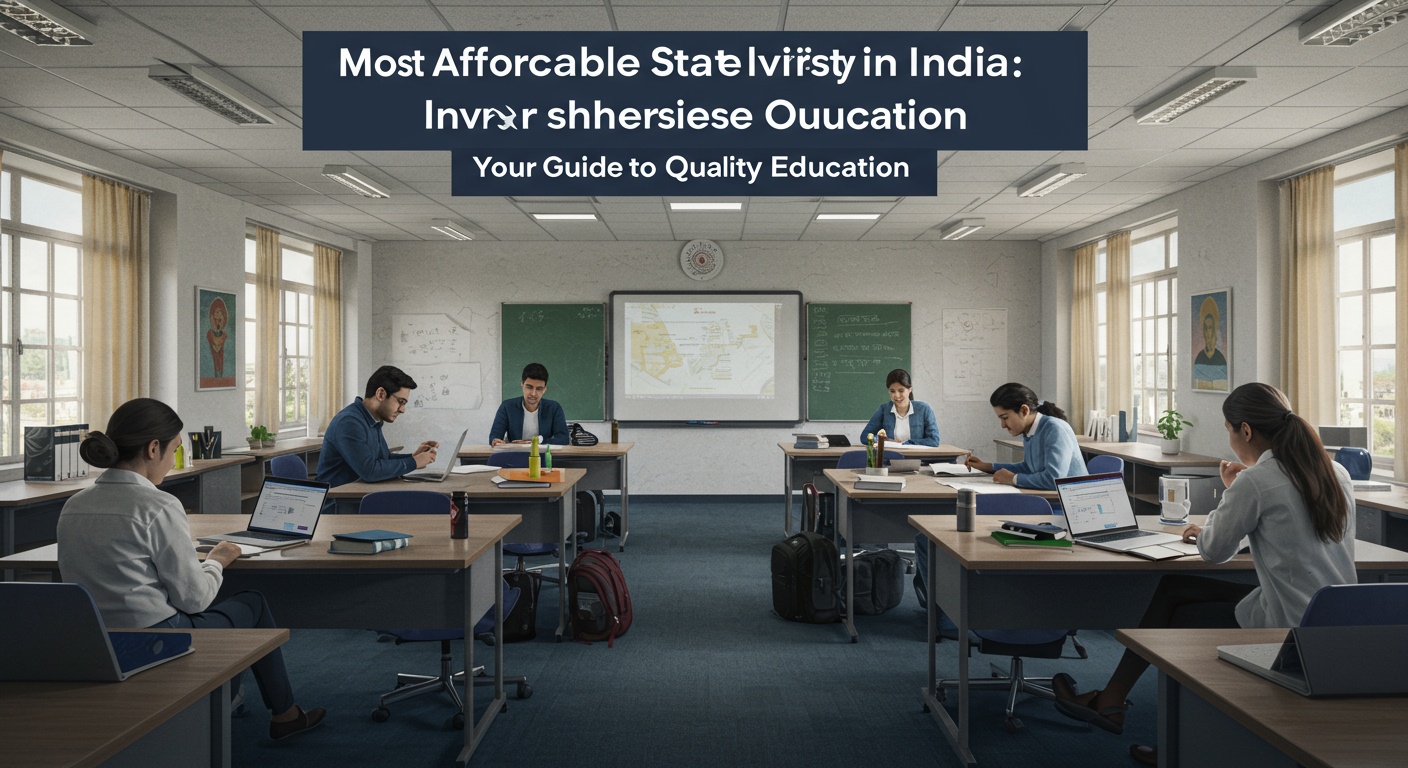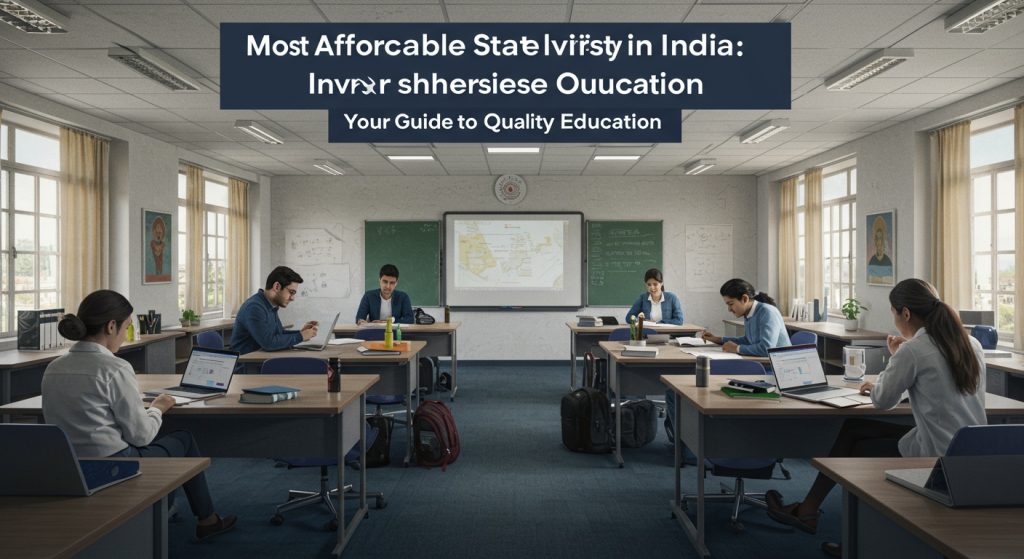Dreaming of a quality education without breaking the bank? India’s state universities are increasingly becoming a viable option, especially with recent initiatives like the National Education Policy 2020 emphasizing accessibility and affordability. Forget outdated perceptions; institutions such as Alagappa University (Tamil Nadu) and Guru Ghasidas Vishwavidyalaya (Chhattisgarh) are actively climbing NIRF rankings while maintaining remarkably low tuition fees. The surge in online degree programs offered by state-funded universities also reduces accommodation costs, making education even more accessible. Discover how strategic choices regarding location and course selection can unlock a world of opportunity, allowing you to invest in your future without crippling debt. Let’s explore the landscape of budget-friendly, high-impact learning across India.

Why Choose State Universities?
State universities in India are funded and run by the respective state governments. They offer a wide array of undergraduate, postgraduate. Doctoral programs across various disciplines. These institutions are often more affordable than private universities, making them a viable option for students from diverse socio-economic backgrounds. Choosing a state university can provide a quality education without incurring exorbitant tuition fees.
- Affordability
- Accessibility
- Diverse Programs
- Government Recognition
Lower tuition fees compared to private institutions.
Wider reach with campuses in various districts and towns.
A broad spectrum of courses across arts, science, engineering, medicine. More.
Degrees are widely recognized and accepted for government jobs and further studies.
Factors Influencing Affordability
Several factors contribute to the affordability of state universities. Understanding these can help you make an informed decision.
- Tuition Fees
- Hostel and Accommodation
- Scholarships and Financial Aid
- Location
The primary cost component; state universities typically have subsidized fees.
On-campus housing is usually more economical than private rentals.
Many state governments and universities offer scholarships based on merit, category, or financial need.
Living expenses in smaller towns and rural areas are generally lower than in metropolitan cities.
Top Affordable State Universities in India
While pinpointing the absolute most affordable can fluctuate yearly, here’s a look at some consistently budget-friendly and academically reputable state universities. Note that “affordable” is relative and depends on the course and individual circumstances.
- Banaras Hindu University (BHU), Uttar Pradesh
- University of Calcutta, West Bengal
- Jadavpur University, West Bengal
- Osmania University, Telangana
- Panjab University, Chandigarh
- Mahatma Gandhi Kashi Vidyapith, Uttar Pradesh
- Dr. Babasaheb Ambedkar Marathwada University, Maharashtra
While a Central University, BHU’s fees are very low compared to private institutions and offers a wide range of courses.
Known for its rich history and diverse academic programs, tuition fees are minimal.
Highly regarded for its engineering and science programs, with affordable tuition.
Offers a wide variety of courses and has affordable fees, particularly for state residents.
Although Chandigarh has a higher cost of living, the university’s tuition fees are reasonable.
A focus on humanities and social sciences makes this a very affordable option.
Located in Aurangabad, this university provides accessible education with lower living costs.
Fees and eligibility criteria are subject to change. It’s always best to check the university’s official website for the most up-to-date details.
Navigating the Application Process
Applying to state universities involves a few key steps. Here’s a guide to help you through the process:
- Research
- Entrance Exams
- Application Forms
- Document Submission
- Counseling and Admission
Identify universities offering your desired course and check their eligibility criteria.
Many state universities conduct their own entrance exams or accept scores from national-level exams like CUET (Common University Entrance Test).
Fill out the online application form carefully, providing accurate data.
Upload scanned copies of required documents, such as mark sheets, identity proof. Category certificates.
Attend counseling sessions (if applicable) and confirm your admission by paying the required fees.
Scholarships and Financial Aid Opportunities
Numerous scholarships and financial aid programs are available to students pursuing higher education at state universities. Here are some notable ones:
- State Government Scholarships
- Central Government Scholarships
- University-Specific Scholarships
- Private Scholarships
Offered by respective state governments based on merit, category (SC/ST/OBC), or financial need.
Schemes like the National Scholarship Portal (NSP) offer various scholarships for students from different backgrounds.
Many universities have their own scholarship programs for deserving students.
Foundations and organizations offer scholarships based on academic performance, extracurricular activities, or specific fields of study.
Explore all available scholarship options and apply well in advance to increase your chances of securing financial aid.
The Role of CUET in State University Admissions
The Common University Entrance Test (CUET) has become increasingly crucial for admissions to many state universities. CUET is a national-level entrance exam conducted by the National Testing Agency (NTA) for admission to undergraduate programs in participating universities across India. This test aims to provide a common platform and equal opportunities to students from different backgrounds.
- Standardized Testing
- Wider Opportunities
- Reduced Competition
CUET provides a standardized method for evaluating students’ abilities, reducing reliance on Class 12 board exam marks.
Students can apply to multiple universities through a single exam.
It potentially reduces the cut-throat competition for admissions based solely on board exam scores.
- Many state universities now use CUET scores as a primary criterion for admission to their undergraduate programs.
- Some universities may give weightage to CUET scores along with Class 12 marks or conduct their own interviews or aptitude tests.
- It’s crucial to check the specific admission policies of the state university you’re interested in to interpret the role of CUET in their selection process.
Living Expenses and Budgeting Tips
While tuition fees at state universities are generally lower, it’s essential to consider living expenses when planning your budget. Here are some tips to manage your finances effectively:
- Accommodation
- Food
- Transportation
- Books and Stationery
- Entertainment
Opt for on-campus hostels, which are typically more affordable than private rentals.
Cook your own meals whenever possible to save money on eating out.
Use public transport or cycle to commute to college.
Borrow books from the library or buy second-hand copies.
Explore free or low-cost recreational activities in your city.
Utilize budgeting apps and spreadsheets to track your expenses and manage your finances effectively.
Real-World Examples: Success Stories from State Universities
Many successful individuals have graduated from state universities in India. These institutions have played a crucial role in shaping careers across various fields. Here are a few examples:
- Sundar Pichai (IIT Kharagpur)
- Arvind Kejriwal (IIT Kharagpur)
- Numerous Civil Servants
An alumnus of the Indian Institute of Technology (IIT) Kharagpur, a state-funded institution, Pichai is now the CEO of Google.
The Chief Minister of Delhi, Kejriwal, also graduated from IIT Kharagpur.
Many IAS, IPS. IFS officers have graduated from state universities and gone on to serve the nation.
These examples highlight the potential for success that state universities can offer, regardless of the lower tuition fees.
Choosing the Right University: A Checklist
Selecting the right state university requires careful consideration. Here’s a checklist to guide your decision-making process:
- Accreditation and Recognition
- Course Curriculum
- Faculty and Infrastructure
- Placement Opportunities
- Location and Accessibility
Ensure the university is recognized by relevant authorities like UGC (University Grants Commission) and NAAC (National Assessment and Accreditation Council).
Review the course curriculum to ensure it aligns with your career goals and interests.
Research the faculty’s expertise and the availability of resources like libraries, labs. Sports facilities.
Check the university’s placement record and the companies that recruit from the campus.
Consider the location of the university and its accessibility from your hometown.
The Future of State Universities in India
State universities in India are evolving to meet the changing needs of the education landscape. Key trends include:
- Increased Focus on Research and Innovation
- Online and Blended Learning
- Industry-Academia Collaboration
- Emphasis on Skill Development
Many state universities are investing in research and development to promote innovation and address societal challenges.
The adoption of online and blended learning models is expanding access to education and enhancing the learning experience.
Partnerships with industries are becoming more common, providing students with practical training and internship opportunities.
Universities are focusing on developing students’ skills and employability through vocational training and skill-based courses.
Top State Universities in India: A Final Word
Choosing the right state university can be a life-changing decision. By considering factors like affordability, academic quality. Career opportunities, you can find an institution that aligns with your aspirations and helps you achieve your goals. Remember to research thoroughly, explore all available options. Make an informed choice.
Conclusion
Choosing the right university is a pivotal decision. Affordability shouldn’t mean compromising on quality. State universities in India offer a fantastic pathway to a brighter future without breaking the bank. Remember that beyond tuition fees, consider the cost of living in different states; sometimes, a slightly “more expensive” university in a smaller town can be overall cheaper. Don’t just look at the immediate cost; think about future career prospects. Are there local industries where you can intern and gain experience? Personally, I found networking at student events hosted by alumni proved invaluable in securing my first job. Explore resources like the NIRF rankings to compare institutions. Also delve into student reviews and department-specific achievements. Ultimately, your success depends on your dedication and proactive approach to learning. Embrace the opportunities available, build your skills. Believe in your potential. The future is yours to shape!
More Articles
Top Central Universities in India: Latest Rankings & What Makes Them Stand Out
Central vs. State University: Which is Right for Your Higher Education Goals?
Most In-Demand Courses: Central Universities to Watch Out for in 2025
Future-Proof Your Degree: Top Skills Students Need for 2025
Unlock Your Potential: Research Opportunities for Undergraduates
FAQs
Okay, so what exactly makes a state university in India ‘affordable’? What are we talking about in terms of fees?
That’s the million-dollar question, right? ‘Affordable’ in this context means the tuition fees are significantly lower than private universities. Expect annual fees ranging from a few thousand rupees to maybe, at the higher end, ₹20,000-₹30,000. It really depends on the specific course and university. Generally MUCH cheaper than private options.
Are these affordable state universities any good? Will I get a decent education?
Good question! Affordability doesn’t necessarily mean low quality. Many state universities have excellent faculty, strong departments (especially in core subjects like science and humanities). Established reputations. Do your research on specific departments and faculty to ensure they align with your interests. Don’t write them off just because of the price tag!
What are some of the most common degree programs offered at these affordable state universities?
You’ll find a wide range! Think Bachelor of Arts (BA), Bachelor of Science (BSc), Bachelor of Commerce (BCom) are super common. Many also offer engineering (BTech), medicine (MBBS – very competitive!) , law (LLB). Other professional degrees. Again, it varies from university to university, so check their specific offerings.
How do I even find these universities? Is there a list somewhere?
Finding them takes a bit of digging. It’s worth it. Start by searching for ‘state universities’ in specific states you’re interested in. Each state government usually has a higher education website listing all its affiliated universities. You can also look at the University Grants Commission (UGC) website. They maintain a list of recognized universities in India.
What about scholarships and financial aid? Are those available for students attending these universities?
Absolutely! Many state governments offer scholarships for students based on merit and/or financial need. The universities themselves might also have their own scholarship programs. Plus, the central government offers several scholarships as well. Definitely explore all your options – a little research here can save you a lot of money.
Is the admission process tough? What exams do I need to take?
The admission process varies. Some universities admit students based on their Class 12 marks, while others conduct entrance exams. For professional courses like engineering and medicine, you’ll likely need to take national-level entrance exams like JEE or NEET. Check the specific admission criteria for the university and course you’re interested in.
Besides tuition, what other costs should I be prepared for when attending an affordable state university?
Good point! Don’t forget about the hidden costs. You’ll need to factor in accommodation (hostel fees or rent), food, books and study materials, transportation. Of course, personal expenses. Even though the tuition is low, these other costs can add up, so plan your budget accordingly.



